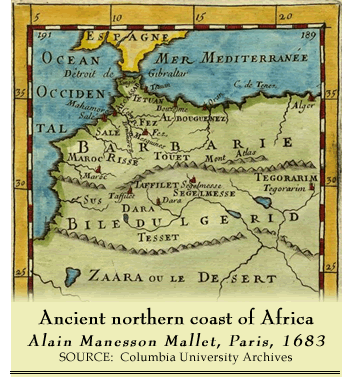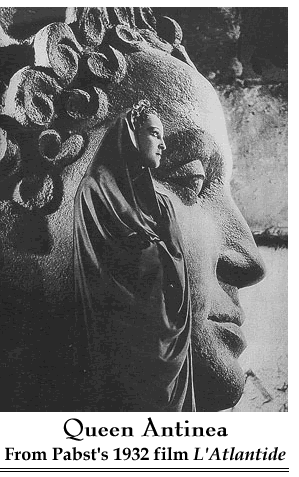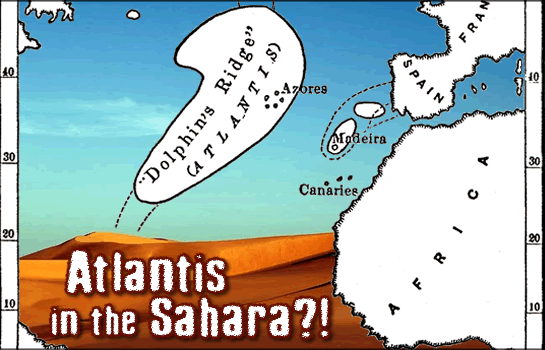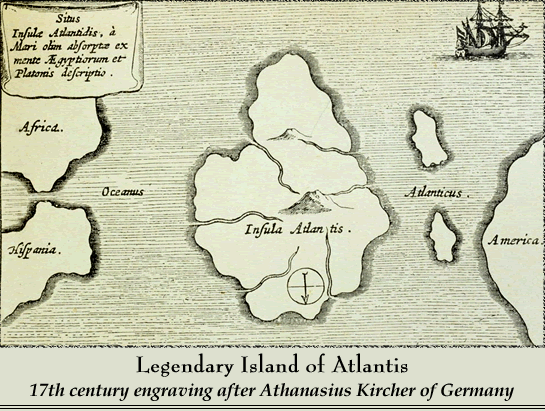Annals of Pseudohistory:
Bury that Theory
Beneath a Sea of Dunes.
So geographers in Afric-maps
With savage-pictures fill their gaps;
And oíer unhabitable downs
Place elephants for want of towns.
— Jonathan Swift
By Ron Fritze from Athens, Alabama
Posted October 14, 2009
Anyone familiar with the history and lore of Atlantis and Atlantology knows that the large catalog of locations suggested for a historical Atlantis covers a significant portion of the lands and seas of the earth. Atlantis, it seems, is everywhere — and nowhere to be found.
In 1954 L. Sprague de Camp listed 188 writers and scholars who had identified Atlantis with a relatively specific geographical location. In the half-century since De Camp compiled his list, hundreds of new books have been written about Atlantis and theories about its location.
The great majority of the theories listed by De Camp identified Atlantis as an island in the Atlantic Ocean, usually now submerged. That is the classic Atlantis theory, which is consistent with Platoís account — if one assumes that Plato was really writing a historical account. Other locations in the Atlantis pantheon of geographical possibilities include Britain, Sweden, France, Palestine, the Arctic, the Antarctic, North and sometimes South America, and the island of Santorini in the Aegean Sea.
Waves of Sand
Among the strangest, most incongruous of suggested locations is the Sahara Desert. Atlantis is a lost continent that sank beneath the waves, or so Plato said. That means a lot of water. The
 Sahara is the worldís largest desert. Its name literally means desert. In a place like the Sahara, there is not a lot of scope for a lost continent or even a more modest island sinking under the sea. To suggest a Saharan location for Atlantis requires an inventive argument and a lot of imagination. Keep in mind, a number of people have suggested Atlantis was located in Morocco, Tunisia, and the Atlas Mountains. Theories locating Atlantis beyond the Atlas Mountains in the Sahara proper are not quite as common.
Sahara is the worldís largest desert. Its name literally means desert. In a place like the Sahara, there is not a lot of scope for a lost continent or even a more modest island sinking under the sea. To suggest a Saharan location for Atlantis requires an inventive argument and a lot of imagination. Keep in mind, a number of people have suggested Atlantis was located in Morocco, Tunisia, and the Atlas Mountains. Theories locating Atlantis beyond the Atlas Mountains in the Sahara proper are not quite as common.
Interestingly, the first person to postulate that Atlantis was located in North Africa was the French botanist D. A. Godron, whose 1868 treatise placed the lost civilization in the Sahara. He was followed by the geographer E. F. Brelioux, who in 1874 claimed that Atlantis once stood along the coast of Morocco between Agadir and Casablanca where the Atlas Mountains came down to the sea. Brelioux suggested that the ancient city of Kernë was the inspiration for the capital city of Atlantis.
Two years later the French medical anthropologist Gustave Lagneau (1827-1896) also suggested that Morocco was the site of Atlantis. The German geographer A. F. R. Knötel published his Atlantis und das Volk der Atlanten in 1893, which also placed Atlantis in Morocco, although he identified the Atlantean priests of the cult of Thoth-Ouranos-Hermes as having originally migrated from Chaldea.
French SciFi Inspires a Revival.
After Knötel, writings about a North Africa/Saharan Atlantis halted until science fiction inspired a pseudohistorical revival.
In 1919 the French novelist Pierre Benoit (1886-1962) published L´Atlantide, his second novel. (His first novel, Koenigsmark, a mystery/romance/thriller set in a castle in pre-World War I Germany, was published in 1918.) L´Atlantide is a fantasy adventure in which two French army officers, Morhange and Saint-Avit, journey into the deep Sahara on a mission of exploration. Nearing the Ahaggar Mountains, they rescue a lone Tuareg named Cegheir-ben-Shiekh from a flash flood. The Tuareg, however, is on a mission of his own. He drugs the two Frenchmen and takes them to the city of Atlantis hidden in the Ahaggar Mountains.
In primeval times, the story goes, the Sahara contained a sea. Atlantis was an island in its midst. Earthquakes raised the bottom of the ancient sea, causing the water to drain off. Atlantis was left high and
 dry, an island of mountains in a sea of desert. The Tuaregs are the descendents of the Atlanteans. Some of them are particularly long-lived, in particular Antinea, the reigning queen of Atlantis and a descendent of Poseidon. Cegheir-ben-Shiekh brought the two Frenchmen to Atlantis as a gift to Queen Antinea, who is eager to satisfy a strange obsession. Antinea is a man-hater whose goal is to seduce 150 men, each of whom who will then become obsessed with her and die of broken hearts when she drops them for a new conquest. When a rejected suitor dies, Antinea has the body embalmed as a statue of orichalc, the mysterious metal of ancient Atlantis. The statues are displayed in a gallery on the premise that once Antinea accumulates 150 such trophies, she will reign in peace as queen of Atlantis, having avenged herself on the men of the outside world.
dry, an island of mountains in a sea of desert. The Tuaregs are the descendents of the Atlanteans. Some of them are particularly long-lived, in particular Antinea, the reigning queen of Atlantis and a descendent of Poseidon. Cegheir-ben-Shiekh brought the two Frenchmen to Atlantis as a gift to Queen Antinea, who is eager to satisfy a strange obsession. Antinea is a man-hater whose goal is to seduce 150 men, each of whom who will then become obsessed with her and die of broken hearts when she drops them for a new conquest. When a rejected suitor dies, Antinea has the body embalmed as a statue of orichalc, the mysterious metal of ancient Atlantis. The statues are displayed in a gallery on the premise that once Antinea accumulates 150 such trophies, she will reign in peace as queen of Atlantis, having avenged herself on the men of the outside world.
Antinea exerts her fatal charms on Morhange, who, as an otherworldly scholar, turns out to be immune to the Atlantean queen. A jealous Saint-Avit kills Morhange and escapes from Atlantis, but only after a rather horrific period of wandering through the desert. Once back in civilization, Saint Avitís fellow officers ostracize him when he admits that he killed Morhange. He also remains obsessed with Antinea. One day he disappears to return to Atlantis and take his place as an orichalum in a niche among the 150 vanquished lovers in the gallery.
L´Atlantide proved to be a very popular novel. Translated into English in 1920 as Atlántida in England and Queen of Atlantis in the United States, the novel has been reprinted a number of times. Most recently it has appeared in the series of classic fantasy and science fiction reprints in the Bison Frontiers of Imagination series published by the University of Nebraska Press.
A Great Story for the Movies
A French silent film adaptation of the novel appeared as L´Atlantide in 1921. The German director Georg Wilhelm Pabst made German, English, and French film versions of the novel in 1932 and 1933 titled respectively Die Herrin von Atlantis, The Mistress of Atlantis, and L´Atlantide. An American film version of the novel appeared in 1949 as Siren of Atlantis, while the French brought out another L´Atlantide film in 1992.
 Benoitís novel was also converted into a Hercules movie by the Italians in 1961. It was was released to English-speaking audiences as Hercules and the Captive Women, but not before the earlier Hercules Unchained (1959 starring Steven Reeves) had appropriated the concept of an evil queen seducing men and turning them into statues. In both movies the granitic Hercules is ultimately able to shake off the shackles of female wiles, something Benoitís doomed heroes are unable to do, except the guileless Morhange.
Benoitís novel was also converted into a Hercules movie by the Italians in 1961. It was was released to English-speaking audiences as Hercules and the Captive Women, but not before the earlier Hercules Unchained (1959 starring Steven Reeves) had appropriated the concept of an evil queen seducing men and turning them into statues. In both movies the granitic Hercules is ultimately able to shake off the shackles of female wiles, something Benoitís doomed heroes are unable to do, except the guileless Morhange.
Pierre Benoitís novel also reignited the production of purportedly nonfiction books locating Atlantis in North Africa. The Belgian physical anthropologist A. L. Rutot in 1921 advocated his own Atlantis-in-Morocco theory. Something of a maverick, Rutot had for years claimed to have found stone tools in European sites that were similar to implements used by aborigines in Tasmania, but dating 25-38 million years ago. His Atlantis contention was seconded in 1922 by the explorer E. L. Genti, who championed the idea of a Moroccan Atlantis.
The Ahaggar Mountains? Morocco?
Tunisia? No, Let's Go with Friesland!
More directly inspired by Benoitís novel was Count Byron Khun de Prorock, an initially talented amateur archaeologist who had turned to sensationalism. Exploring deep into the Sahara in 1925, he penetrated the Ahaggar Mountains and concluded they were a possible location for a historical Atlantis. That same year Mario Vivarez joined the throng, claiming that Morocco was Atlantis. The German Albert Hermann added Tunisia to the possible locations for the lost continent, although he claimed that the original Atlantis was located in Friesland.

In 1926 the librarian Claude Roux returned to Godronís original suggestion that the Sahara was the lost land of Atlantis, although he located it in what is now Libya. A few years later in 1930, Otto Silbermann also advocated Libya as the site of Atlantis, but he claimed that Platoís story of the lost civilization was based on a war between the Phoenicians and Libyans that had occurred in the desert. Bernard Marque in 1933 made the same claim for Atlantis in North Africa.
We are left with the base conclusion that Atlantology is not an exact science. Given the flexible and fluid nature of the enterprise, theories about Atlantis abound — and most are mutually contradictory. That in itself raises some doubts about the existence of a historical Atlantis. Among the least plausible of the many speculative theories are those that place Atlantis somewhere in North Africa, whether they preceded or followed Benoitís classic L´Atlantide.
Click on the black panther to read about Ron Fritze's new book,
Invented Knowledge: False History, Fake Science, and Pseudo-religions. |




 Sahara is the worldís largest desert. Its name literally means desert. In a place like the Sahara, there is not a lot of scope for a lost continent or even a more modest island sinking under the sea. To suggest a Saharan location for Atlantis requires an inventive argument and a lot of imagination. Keep in mind, a number of people have suggested Atlantis was located in Morocco, Tunisia, and the Atlas Mountains. Theories locating Atlantis beyond the Atlas Mountains in the Sahara proper are not quite as common.
Sahara is the worldís largest desert. Its name literally means desert. In a place like the Sahara, there is not a lot of scope for a lost continent or even a more modest island sinking under the sea. To suggest a Saharan location for Atlantis requires an inventive argument and a lot of imagination. Keep in mind, a number of people have suggested Atlantis was located in Morocco, Tunisia, and the Atlas Mountains. Theories locating Atlantis beyond the Atlas Mountains in the Sahara proper are not quite as common. dry, an island of mountains in a sea of desert. The Tuaregs are the descendents of the Atlanteans. Some of them are particularly long-lived, in particular Antinea, the reigning queen of Atlantis and a descendent of Poseidon. Cegheir-ben-Shiekh brought the two Frenchmen to Atlantis as a gift to Queen Antinea, who is eager to satisfy a strange obsession. Antinea is a man-hater whose goal is to seduce 150 men, each of whom who will then become obsessed with her and die of broken hearts when she drops them for a new conquest. When a rejected suitor dies, Antinea has the body embalmed as a statue of orichalc, the mysterious metal of ancient Atlantis. The statues are displayed in a gallery on the premise that once Antinea accumulates 150 such trophies, she will reign in peace as queen of Atlantis, having avenged herself on the men of the outside world.
dry, an island of mountains in a sea of desert. The Tuaregs are the descendents of the Atlanteans. Some of them are particularly long-lived, in particular Antinea, the reigning queen of Atlantis and a descendent of Poseidon. Cegheir-ben-Shiekh brought the two Frenchmen to Atlantis as a gift to Queen Antinea, who is eager to satisfy a strange obsession. Antinea is a man-hater whose goal is to seduce 150 men, each of whom who will then become obsessed with her and die of broken hearts when she drops them for a new conquest. When a rejected suitor dies, Antinea has the body embalmed as a statue of orichalc, the mysterious metal of ancient Atlantis. The statues are displayed in a gallery on the premise that once Antinea accumulates 150 such trophies, she will reign in peace as queen of Atlantis, having avenged herself on the men of the outside world. Benoitís novel
Benoitís novel 

